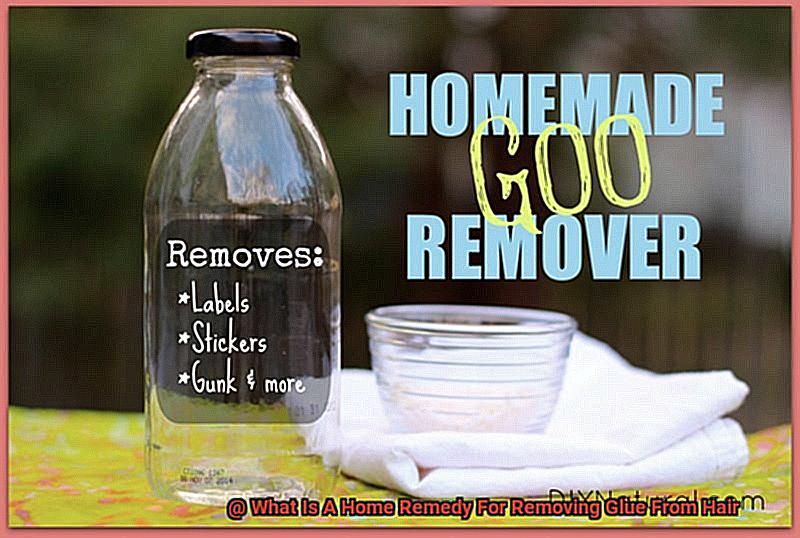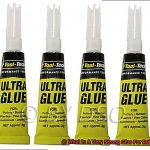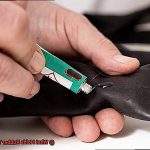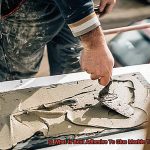Ever been stuck with glue in your hair?
It’s the worst, right? Whether it’s from a craft disaster or a beauty experiment gone sideways, it can make you feel like you’re glued to your seat.
But don’t panic just yet. In this blog post, we’re diving into the mesmerizing realm of home remedies for getting rid of that pesky glue in your hair.
So sit tight, loosen those stubborn strands, and prepare to uncover some tried-and-true methods for freeing yourself from sticky situations – quite literally.
What is Glue and How Does it End Up in Hair?
Contents
Glue, a sticky substance comprised of polymers, resins, and solvents, is commonly utilized to bond materials together. Craft glue, school glue, and industrial glue are just a few examples of the different types available, each with its own specific uses and compositions.
Glue can find its way into hair through various means. During arts and crafts activities, children may unintentionally get glue on their hands or fingers and subsequently transfer it to their hair while playing or absentmindedly touching their locks.
Hair extensions are another culprit in glue-related hair mishaps. Certain methods of attaching extensions involve adhesive glues. If not applied or removed correctly, these glues can adhere to natural hair strands, leading to tangles and mats.
In addition, glue can also become entangled in hair during construction or DIY projects. Individuals working with adhesives may inadvertently get glue on their hair when handling materials or applying it to surfaces. The strong bond of the glue poses challenges when attempting to remove it from the hair without proper techniques or remedies.
Fortunately, there are several home remedies for removing glue from hair. Cooking oil or baby oil can be used to loosen the adhesive, which can then be combed out. Peanut butter’s natural oils can also break down the glue. A mixture of vinegar and water can be dabbed onto the affected area to dissolve the glue. Additionally, generously applying mayonnaise or margarine and leaving it on for a few minutes before combing through can help remove the sticky substance.
Common Home Remedies for Removing Glue from Hair
Common home remedies for removing glue from hair include using oils such as olive oil, coconut oil, or baby oil. These oils help break down the adhesive properties of the glue, making it easier to remove. Apply a generous amount of oil to the affected area and massage it into the hair, focusing on the glue-covered strands. Leave it on for about 30 minutes before using a wide-toothed comb to carefully remove the glue. Rinse out the oil and follow up with shampoo and conditioner.

Another effective home remedy is using peanut butter. The oils in peanut butter can help loosen the glue. Apply a generous amount of peanut butter to the glue-covered hair and massage it in. Let it sit for about 10 minutes before combing through the hair with a wide-toothed comb to remove the glue. Rinse out the peanut butter and wash with shampoo and conditioner.
Vinegar is also known for its adhesive-dissolving properties. Mix equal parts vinegar and water in a spray bottle and apply it to the glue-covered hair. Let it sit for a few minutes before gently combing through the hair to remove the glue. Rinse out the vinegar mixture thoroughly with water and wash with shampoo and conditioner.
Mayonnaise can also be used to remove glue from hair. Apply a generous amount of mayonnaise to the affected area, cover with a shower cap or plastic wrap, and leave it on for at least an hour before shampooing and rinsing.
Other remedies include using lemon juice or rubbing alcohol. Apply freshly squeezed lemon juice or rubbing alcohol to the affected area, let it sit for a few minutes, then rinse thoroughly with water and follow up with shampoo and conditioner.
Cooking Oil or Baby Oil
When it comes to the battle against glue in hair, there are two household heroes that often step up to the plate: cooking oil and baby oil. These oils possess unique properties that can aid in the removal of glue from hair, but let’s take a closer look at the pros and cons of each option.
When it comes to effectiveness, cooking oil takes the spotlight. Whether it’s vegetable oil or olive oil, this kitchen staple has the power to dissolve glue’s adhesive properties. By breaking down the bond between the glue and the hair strands, cooking oil makes it easier to remove the sticky situation at hand. On the other hand, baby oil is no slouch either. While not as potent as cooking oil, baby oil’s moisturizing and softening properties can still loosen glue from hair effectively.
Now, let’s talk safety. Cooking oils are generally safe for use on hair and skin; however, some individuals may have sensitivities or allergies to certain types of cooking oils. To be on the safe side, it is recommended to perform a patch test before applying it to a larger area. Baby oil, on the other hand, is specifically formulated for use on delicate baby skin, making it generally safe for use on hair. Nevertheless, those with sensitive skin should also conduct a patch test to avoid any potential reactions.
When considering possible side effects, both cooking oil and baby oil have their own considerations. In rare cases, some individuals may experience skin irritation or allergic reactions to cooking oils. If any adverse reactions occur, it is best to discontinue use immediately. As for baby oil, excessive use or leaving it on the hair for too long may lead to greasy or oily locks.
Now that we’ve covered the basics, let’s talk about recommended products. Any type of cooking oil can be used for this purpose, but vegetable or olive oil are commonly recommended due to their availability and effectiveness. When it comes to baby oil, there are various brands on the market. Look for one that is hypoallergenic and free from added fragrances or dyes to minimize the risk of irritation.
To fully remove glue stains, here are a few potential solutions. After applying either cooking oil or baby oil to the affected area, gently comb through the hair to remove any loosened glue. If the glue does not come off easily, you can try using a mild shampoo or dish soap to help remove any residue left behind. It may take multiple attempts and some patience, but with time and effort, you can bid adieu to those sticky remnants.
Peanut Butter
Peanut butter is a beloved staple in many households, known for its rich and creamy texture and delicious taste. But beyond its culinary uses, peanut butter also has some surprising qualities that make it useful in unexpected ways. One such use is as a remedy for removing glue from hair. The natural oils and fats present in peanut butter have the remarkable ability to break down the adhesive properties of glue, making it easier to remove from hair strands.
To effectively use peanut butter to remove glue from hair, it is important to follow a step-by-step process. Begin by gathering the necessary supplies, including peanut butter (smooth or creamy), a wide-toothed comb, warm water, and shampoo. Apply a generous amount of peanut butter directly onto the area with the glue, ensuring that all affected hair strands are covered. Gently massage the peanut butter into the hair, ensuring that it reaches all the glued areas. This will help the natural oils in the peanut butter penetrate and loosen the glue.
Allow the peanut butter to sit on the hair for about 10-15 minutes. This waiting period allows sufficient time for the peanut butter to break down the adhesive properties of the glue. Once the time is up, use a wide-toothed comb or your fingers to gently comb through the hair, starting from the ends and working your way up towards the scalp. As you comb through, you will notice that the glue starts to break down and become easier to remove.
After combing through the hair, rinse it thoroughly with warm water to remove any remaining peanut butter and glue residue. It may be necessary to repeat this process multiple times depending on the amount of glue and type of adhesive used. Finally, shampoo and condition your hair as usual to ensure that all traces of peanut butter and glue are removed.
Vinegar
Vinegar, a household staple, has long been celebrated for its versatility and multitude of uses. From cooking and cleaning to medicinal purposes, vinegar has proven itself to be an indispensable ingredient. One of its lesser-known applications is in removing glue from hair. Yes, you read that right. Vinegar’s acidic properties make it a powerful ally when it comes to breaking down adhesives and freeing your hair from their sticky grasp.
When using vinegar as a remedy for removing glue from hair, it’s important to start by diluting it with water. This ensures that the vinegar is gentle on your locks while still being effective in dissolving the stubborn glue. A mixture of equal parts vinegar and water is ideal for this purpose.
Once you have your vinegar solution ready, apply it generously to the areas of your hair affected by the glue. Gently massage the solution into your strands, allowing the acidic properties of vinegar to work their magic. Give it a few minutes for the solution to penetrate and soften the adhesive.
Now comes the fun part – combing out the glue. Using a fine-toothed comb or your fingers, carefully work through your hair, loosening any remaining traces of adhesive. Be patient and gentle during this process to prevent any damage or breakage.
After you’ve successfully removed most of the glue, rinse your hair thoroughly with warm water. This will wash away any residue, leaving your tresses clean and free from any lingering traces of adhesive or vinegar. For an extra level of cleanliness, you can follow up with a mild shampoo and conditioner.
It’s important to note that while vinegar can be an effective home remedy for removing glue from hair, it may not work on all types of adhesives or if the glue has been left on for an extended period. In such cases, seeking professional help or exploring alternative methods may be necessary.
Mayonnaise or Margarine
When it comes to culinary debates, few are as heated as the mayonnaise versus margarine showdown. These two condiments have sparked controversy and divided households for decades. Let’s delve into the world of mayonnaise and margarine to understand their differences and settle this debate once and for all.
Mayonnaise, a creamy concoction made from eggs, oil, and vinegar or lemon juice, is a staple in many households. It boasts a rich and tangy flavor that adds a delightful creaminess to sandwiches and salads. Mayonnaise also packs a powerful punch when it comes to removing glue from hair. Its high oil content acts as a lubricant, breaking down the adhesive properties of glue and allowing it to slide off the hair strands effortlessly. Additionally, its moisture-rich formula hydrates and softens the hair, reducing the risk of damage during the removal process.
On the other hand, margarine is a spreadable butter substitute made from vegetable oils. It mimics the creamy texture of butter but with a lower saturated fat content. Margarine, too, can be enlisted in the battle against glue-ridden strands. Like mayonnaise, it contains oils that can dismantle the sticky grip of glue. Its slippery consistency makes combing through tangled hair a breeze without causing unnecessary friction or pulling.
To use mayonnaise or margarine for glue removal, the process is similar. Apply a generous amount of either condiment to the affected areas of hair and gently massage it in. Let it sit for 15-20 minutes to allow the oils to dissolve the glue. Rinse thoroughly with warm water and follow up with shampoo to ensure all traces of condiment and adhesive are banished.
However, it’s important to note that success with these home remedies may vary depending on factors such as the type and amount of glue, hair type, and duration of the glue’s residence on the hair. It’s always wise to exercise caution and consult a professional if needed.
Patience is Key
Patience is not only important when it comes to removing glue from hair, but it is also a valuable asset in various aspects of life. Whether it’s waiting for things to fall into place, navigating through challenging situations, or achieving long-term goals, patience plays a crucial role in our overall success and well-being.
When dealing with glue in hair, rushing or using harsh methods can lead to further damage. It’s essential to approach the situation calmly and take the time to understand the best approach for removal. Different types of glue require specific methods, so it’s important to identify the type and proceed accordingly.
One popular home remedy for removing glue from hair is using oil. Oils like coconut oil, olive oil, or baby oil can effectively break down the glue and make it easier to remove. By applying a generous amount of oil to the affected area and gently massaging it into the hair, the glue softens over time. Giving the oil a few minutes to work its magic is crucial.
Patience is key during the removal process. Carefully combing through the hair with a fine-toothed comb or using your fingers to gently separate the strands helps minimize breakage or damage. Pulling or tugging on the hair should be avoided at all costs.
If the glue remains stubborn and doesn’t seem to budge with oil alone, other options can be explored. A mixture of dish soap and warm water can be created to break down the glue further. Applying this soapy solution and letting it sit for a few minutes before combing through the hair gently can yield positive results.
Vinegar or lemon juice diluted with water are acidic solutions that can also help dissolve stubborn glue. Applying the mixture, allowing it to sit for a few minutes, and then gently combing through the hair can be effective.
It’s important to acknowledge that these methods may require multiple attempts before all of the glue is completely removed. Patience and persistence are key to achieving successful results.
After successfully removing the glue, it is crucial to thoroughly wash and condition the hair to eliminate any residue from the remedies used. Applying a deep conditioning treatment can also help restore moisture and nourish the hair.
If all efforts fail, seeking professional help from a hairstylist or salon is the best course of action. They possess the experience and expertise to handle such situations and provide suitable guidance and solutions.
Consulting a Professional Hairstylist
Removing stubborn glue from your hair can be a frustrating and challenging task. However, the benefits of consulting a professional hairstylist are numerous and ensure a safe and effective removal process. In this essay, we will explore the advantages of seeking professional help, including their expertise in handling different types of glue, access to specialized tools, understanding of different hair types, and guidance on post-removal care.
Expertise in Handling Different Types of Glue:
Professional hairstylists possess extensive knowledge and experience when it comes to dealing with various types of glue. Whether it’s the adhesive used in hair extensions, wigs, or DIY hair experiments, they can identify the specific glue and understand its properties. This expertise allows them to choose the most appropriate method for removal, ensuring minimal damage to your hair.
Access to Specialized Tools:
Equipped with specialized tools and products, professional hairstylists have everything they need to safely remove glue from your hair. These tools include adhesive solvents and removers formulated specifically for removing glue without causing harm. With their expertise in using these products effectively, you can trust that the removal process will be efficient and minimize any potential damage.
Understanding of Different Hair Types:
Hair comes in various textures, thicknesses, and porosities, all of which affect how glue adheres to it and how it should be removed. Professional hairstylists take these unique hair characteristics into account when planning the removal process. This personalized approach ensures that your hair remains healthy and undamaged throughout.
Guidance on Post-Removal Care:
After successfully removing the glue, professional hairstylists can provide valuable guidance on post-removal care for your hair. They can recommend suitable products or treatments to restore moisture and nourishment after prolonged exposure to adhesive. This guidance is essential in maintaining the health and integrity of your hair, leaving it looking and feeling its best.
DnzKzX3154c” >
Conclusion
In conclusion, there are numerous home remedies that can come to your rescue when it comes to removing glue from hair. You can turn to trusty cooking oil or baby oil, which work wonders in loosening the adhesive and making it easier to comb out. Another option is peanut butter, with its natural oils breaking down the stubborn glue. For a powerful adhesive-dissolving solution, mix vinegar and water together. And let’s not forget about the generous application of mayonnaise or margarine, left on for a few minutes before combing through.
Each remedy has its own unique benefits and considerations. Cooking oil is highly effective, but be sure to patch test for allergies. Baby oil is generally safe for hair use, but make sure to rinse properly to avoid any greasiness. Peanut butter may require multiple attempts for complete removal, but its adhesive-dissolving properties are worth the effort. Vinegar is a powerful glue-breaker, although it may not work on all types of glue. And when using mayonnaise or margarine, be prepared for thorough washing and conditioning afterwards.
If all else fails, seeking the expertise of a professional hairstylist is your best bet. They have the knowledge and tools needed to handle different types of glue and can provide guidance on post-removal care tailored to your specific hair type.
Throughout the removal process, remember that patience is key. Take your time and be gentle with your hair as you follow the recommended steps for each remedy.






